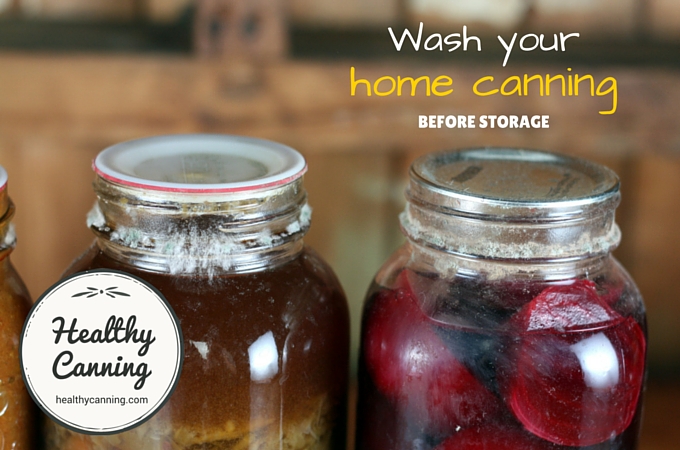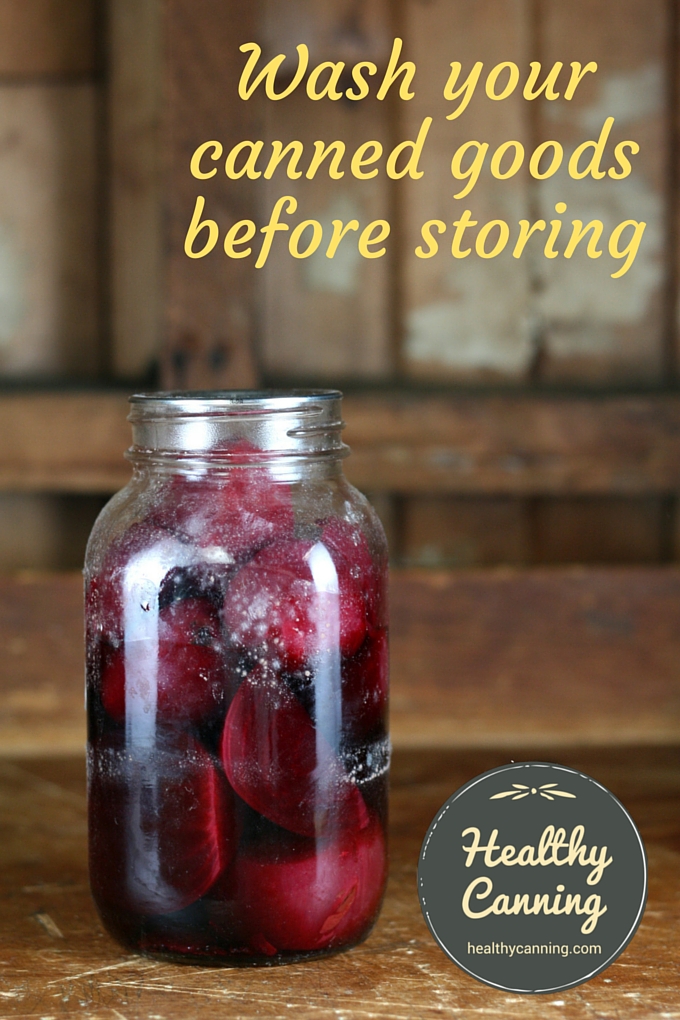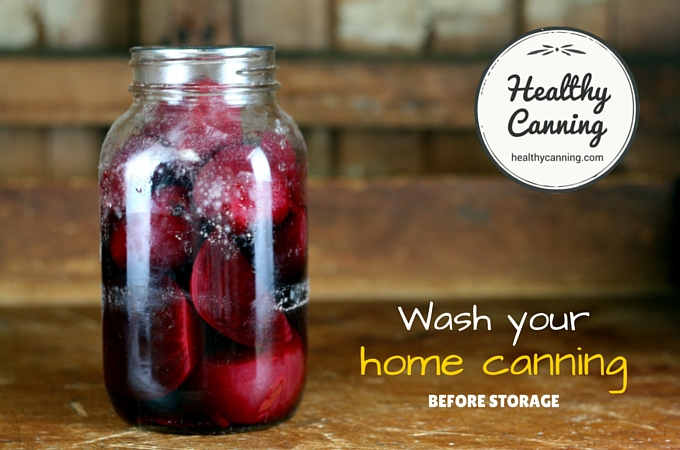It’s important to wash your jars of home canning before storing them away. Moulds and pests will find small particles of food on the jars that your eyes miss.
Why wash your jars
All of nature is constantly in search of food, and in particular, it seems, food in your house.
After the canning process, there will often be minute particles of food on outsides of the jars, particularly on the rim, that you can’t see.
Even those minute particles of food count as a feast to many small critters. Yeast moulds, insects and small rodents will be attracted to them.
A jar may appear clean, or “good enough”, when you put it on the shelf late one fall, but when the humidity of early summer starts to hit next year, moulds in the air may find the jar to be a feasting ground.
Mould on the outside of a jar does not of course affect one bit the food safely sealed inside the jar, but it is very unappealing, and it is not going to increase anyone’s confidence in the quality of your canning.
Sometimes small amounts of starches or sugars in your food are there even though not very visible. These residues can support the growth of mold with even a little bit of humidity in the environment.” [1] Andress, Elizabeth. What Lies Beneath: Let’s Clean Up Jars for Storage. Preserving Food at Home blog entry. 8 December 2015. Accessed December 2015.
Small rodents attracted to food particles on the outside of your jars could be tempted to gnaw through plastic lids, such as Tattlers.
Ants and fruit flies might find the food particles all the food they need to supply a small colony.

Imagine having someone you gifted a jar of home canned goods to report to you (or others) that mould grew all over it.
Imagine too the horror of gifting someone a jar of your home canned goods and them reporting to others that the exterior of the jar you gave them turned into a furry mould colony.
The last thing anyone in their right mind wants to do is add another step to wrapping up the canning process.
But taking this step of washing the jars is well worth it.
How to wash your jars
Remove canning rings from jars; check your seals. Place any jar whose seal failed in the refrigerator for use within the next few days.
(All things considered, it is probably to do that step first, away from the sink. If a jar should prove unsealed, you don’t its contents pouring out into hot soapy water.)
Put some hot soapy water in a sink.
Put the canning rings in; swirl them around, wash dirtier ones more thoroughly as needed, then spread out on a tea towel or drying pad to dry. This usually takes a day or so. When dry, store away for another use. See our page with ideas about how to store your canning rings when not in use.
With a cloth, wash down the sides of the jars, paying particular attention to the rim at the top. Wipe off the lid as well. Rinse in hot water. Repeat for all jars.
Set jars aside to dry (wipe down with a tea towel to speed up process, if desired.) Then label with name and date of product, and store the jars without the canning rings on.
(Note: You can also wash canning rings in a dishwasher. The makers advise against doing this, because it will shorten the lifespan of them: but sometimes you have such a huge stock of them, and so many to clean at once, that the shortcut can be tempting. Do NOT, however, put your jars of canned goods through the dishwasher.)
Store your jars without the canning rings on
Experts used to say they didn’t mind one way or the other if you stored your canning with the canning rings on. Now, though, there is a definite recommendation from the National Center for Home Food Preservation to store jars without canning rings on them.
The primary reason for doing so is to avoid a false seal. It’s the vacuum seal on the flat part of the lid that keeps the food inside the jar safe, not the canning ring holding the lid down, and if that seal goes, you want to know about it.
But, removing the rings and leaving them off provides the additional advantage of helping to ensure that jars stored away are clean. You have to take the rings off anyway to clean properly underneath them, where most of any food gunk will be. It would be more work to put them back on, and if in washing the jar you missed any spots on the rims and moulds start growing there, a canning ring would mask the problem. No one wants moulds growing in their house, anywhere.
We recommend storing jars without ring bands. If mold does start to grow on them, or if seals are broken, you are more likely to notice this and won’t be surprised when you go to use the jar.” [2]Andress, Elizabeth. What Lies Beneath: Let’s Clean Up Jars for Storage. Preserving Food at Home blog entry. 8 December 2015. Accessed December 2015.
What if mould does grow on my jars?
Check the seal on the jar. If it is intact, the food inside the jar is unharmed.
It’s best not to allow mould to remain on jars on the shelf, because mould spores in the air of your house can be adverse to health.
Wash the jars in hot soapy water, and rinse. Or, wipe the jars down with disinfectant wipes, and rinse.
Above all, ensure that mould is cleaned off from the rim before opening a jar, to ensure that none comes into contact with the food.
If you wash your jars before storage, though, such occurrences should be extremely rare and really only happen when you were too tired or distracted to do a 100% thorough job of washing the jars before storage, as can happen to anyone.
Further reading
Andress, Elizabeth. What Lies Beneath: Let’s Clean Up Jars for Storage. Preserving Food at Home blog entry. 8 December 2015.
What is the shelf life of home canned goods?
Store your home canned goods without the canning rings on
References





Lori Snyder
Just noticed something while reading this page. Under the heading “How to wash your jars”, there is an error….it says “Then label with name and product of product,” but shouldn’t it say label with name and date of product?
Healthy Canning
Thanks for catching that typo. You’re right, should be “date.” Fixed.
MARTHA
I MAY HAVE OVERFILLED A COUPLE OF MY BREAD N BUTTER PICKLES IN 8 OZ JARS. THE LIDS SEEM TO BE ALL IN TACT BUT NOTICED SOME STICKINESS ON SOME OF THE THE 8 OZ JARS. I AM GOING TO WASH THEM WELL.
DO YOU THINK IF THE LIDS ARE ON TITE THAT THEY ARE SAFE? PLAN TO STORE WITHOUT BANDS. PROCESSED IN STEAM CANNER FOR 40 MIN
THANK YOU!
Healthy Canning
If the flat part of the lid is secure, and you processed for the time required by your recipe, then wash, label and store.